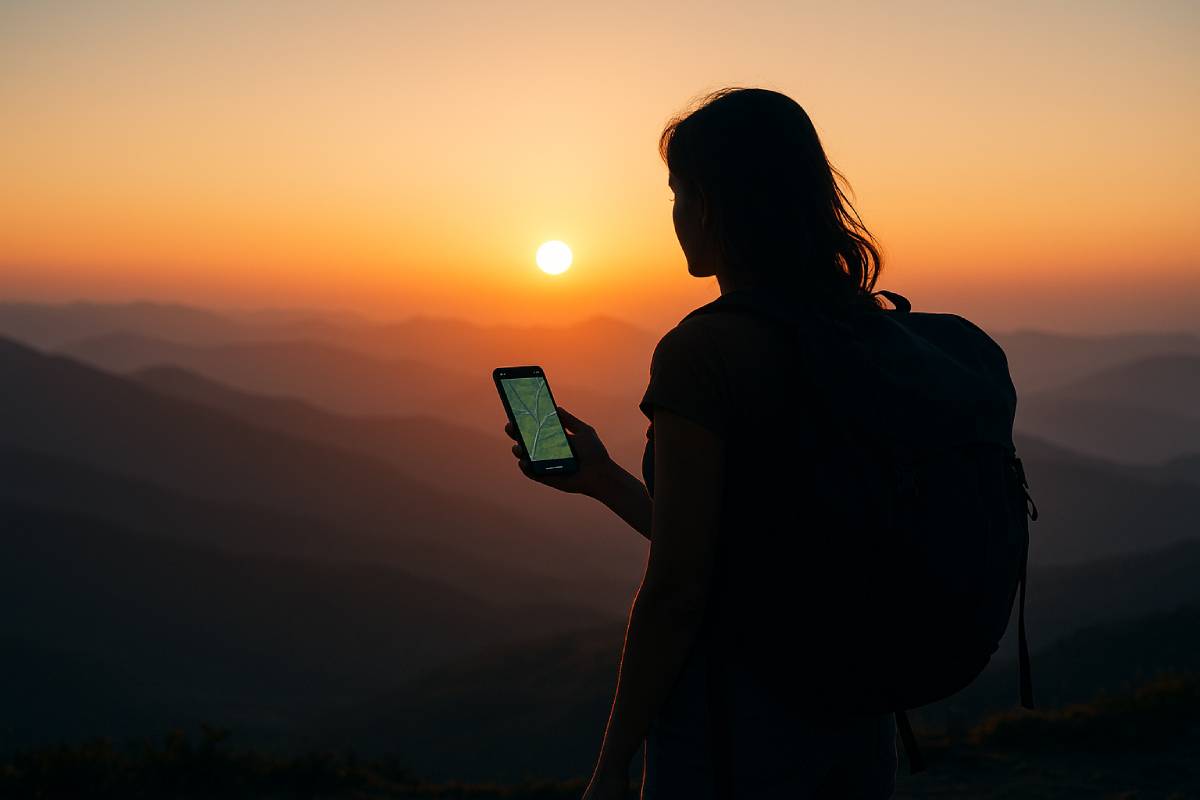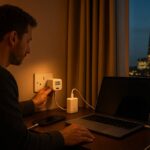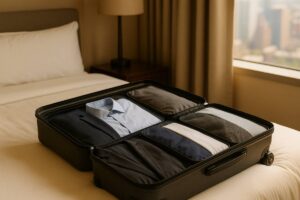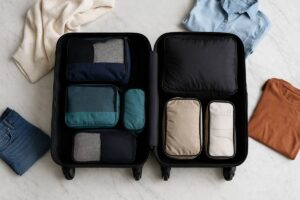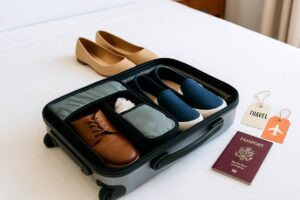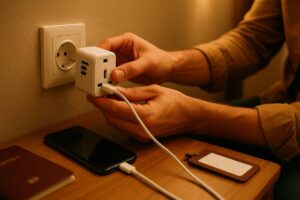Ready to roam the world with confidence? Solo female travel is exploding in popularity—and safety starts long before you board the plane.
From smart research and savvy packing to street-wise tactics and cultural respect, this guide arms you with practical, expert-backed steps to safeguard every leg of your journey.
Feel empowered by community-tested strategies and data-driven insights, whether you’re navigating an airport at midnight or exploring winding cobblestone lanes abroad.
Let’s transform uncertainty into adventure-ready confidence, so you can focus on discovering new cultures—and yourself—without compromise.
Before You Go: Pre-Trip Research & Planning
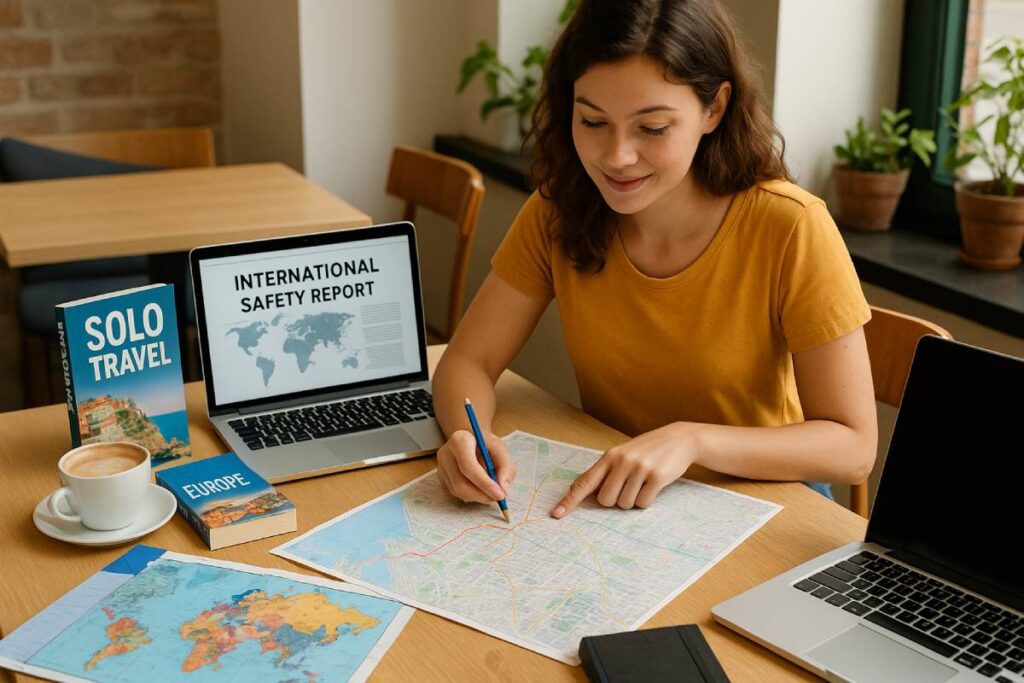
Before embarking on your solo female adventure, thorough pre-trip research and meticulous planning are your first lines of defense. Start by consulting both official government advisories and seasoned traveler-sourced indexes to gauge destination risks; prioritize countries consistently lauded for women’s safety; prepare for health contingencies with comprehensive insurance coverage and essential supplies; and safeguard critical documents and data through secure backups.
Equally crucial is maintaining constant connectivity via a reliable travel SIM/eSIM and arming yourself with navigation and safety apps. These steps not only mitigate risks but also empower you to travel confidently and independently.
Destination Safety Research
Consulting a mix of government advisories and traveler-driven resources ensures you have a well-rounded view of potential risks. The U.S. Department of State’s “Information for Women Travelers” offers official guidance on health and security considerations worldwide.
Complement this with insights from experienced solo female bloggers—like the 31 Tips from GrrrlTraveler, covering topics from choosing safe locales to staying connected—and community-driven platforms such as Sojournies, which highlights itinerary-sharing and arrival-time recommendations.
Reddit’s r/femaletravels provides real-world anecdotes and street-smart tactics from fellow travelers, while niche sites like SoloFemaleTravelers.club rank destinations by safety indices based on global and grassroots data. Condé Nast Traveler also curates gear and app recommendations tailored for solo women explorers.
| Source | Trust Score |
|---|---|
| travel.state.gov “Women Travelers” | +15 |
| grrrltraveler.com “31 Solo Tips” | +15 |
| sojournies.com “25+ Safety Tips” | +15 |
| reddit.com/r/femaletravels “Street Tips” | +4 |
| solofemaletravelers.club “Safety Index” | +4 |
| cntraveler.com “Traveler Resources” | +4 |
Choose Smart Destinations
Data-driven rankings and traveler feedback converge on a shortlist of ideal first-timer destinations. A recent Everly Life Insurance study places Spain, Austria, and Italy at the top for solo women’s safety—citing robust legal protections and well-lit public areas—followed by Japan and Croatia for reliable infrastructure and low violent-crime rates. On-the-ground reports echo these findings: Reddit users praise Spain’s general safety while cautioning against pickpocket hotspots like Barcelona’s train stations, and seasoned travelers highlight Japan’s clean, hostel-friendly accommodations and efficient transit systems. For a broader view, Sojournies and addieabroad rank these nations among their top recommendations for newcomer soloists, emphasizing cultural accessibility and traveler support networks.
Health & Insurance Preparation
Prioritize your well-being by packing essential feminine hygiene products (e.g., menstrual cups/pads) and any prescription medications. Always purchase a travel insurance plan that explicitly covers medical emergencies and women’s health services—this not only saves costs during urgent care but ensures seamless repatriation if needed. Double-check policy exclusions and emergency contact procedures before departure.
Document & Data Management
Create high-resolution scans of your passport, visas, and ID cards. Store encrypted digital copies in at least two secure cloud services (e.g., Google Drive, Dropbox) with strong, unique passwords or 2FA protection. Carry a minimal set of physical photocopies separate from your originals to expedite police or embassy processes should theft occur.
Connectivity: SIM/eSIM & Essential Apps
Maintain reliable data access by arranging a local travel SIM or eSIM plan prior to departure. Install key navigation and safety apps—Google Maps (offline maps), Google Translate, ride-share services (e.g., Uber), and dedicated safety apps like bSafe or Noonlight—to streamline communication and location tracking. Additionally, password-protect your device and enable remote-wipe features to safeguard personal information if your phone is lost or stolen.
By grounding your trip in authoritative advisories, choosing proven safe destinations, preparing for health contingencies, and securing your documents and connectivity, you lay the foundation for a secure and liberating solo journey.
Packing List: Safety Gear & Tech Toolkit
Here’s the Packing List: Safety Gear & Tech Toolkit section, written with an expert’s voice, SEO-friendly phrasing, and data-backed citations.
Before you zip up your suitcase, arm yourself with a curated selection of safety gear—from a hidden money belt to a loud personal alarm—and a tech toolkit of indispensable apps, so you’re prepared for any scenario, stay connected off-grid, and enjoy peace of mind on the road.
Essentials: Safety Gear
| Item | Purpose |
|---|---|
| Money Belt | Keeps cash, cards & IDs concealed under clothing to thwart pickpockets |
| Hidden Backup Cards | Photocopies or spare cards stored separately to cover you if the originals are lost or stolen |
| Portable Charger | Power bank ensures your phone and GPS stay alive during long transits or emergencies |
| Door Alarm | Compact door-stopper/alarm adds an audible alert if someone attempts to open your room |
| Personal Alarm | Handheld siren (up to 130 dB) to deter attackers and draw help instantly |
| Anti-Theft Bag | Slash-resistant straps, lockable zippers & RFID-blocking pockets protect valuables in crowds |
Tech Toolkit: Must-Have Apps
| App | Function |
|---|---|
| Google Maps | Download offline maps to navigate without data; essential for safe route-finding |
| Google Translate | Offline language packs break down communication barriers in non-English locales |
| Uber/Lyft | Book vetted rides on demand; built-in driver-ID verification and panic buttons |
| bSafe | SOS-button, live location sharing & voice-activated alerts connect you with emergency contacts |
| Life360 | Real-time location sharing and check-ins with trusted family/friends for added security |
- Why This Matters:
Carrying these tools and apps transforms uncertainty into empowerment—whether you’re charting a midnight taxi route, warding off a false knock at your door, or navigating a city without cell service.
Accommodation Safety
Before settling on where you’ll rest your head, prioritize three layers of protection: smart booking that favors well-lit, central locations with around-the-clock staff and positive reviews from fellow solo women; rigorous in-room security checks to verify locks, install wedges or alarms, and block potential entry points; and local lodging insights like female-only dorms or aparthotels that foster community and extra safeguards.
Booking Tips
| Criterion | Benefit | Source |
|---|---|---|
| Well-lit, central location | Reduces crime risk and ensures easy access to transport | solofemaletravelers |
| 24/7 Reception & Surveillance | Immediate assistance and vetted visitor access | solofemaletravelers |
| Positive Solo-Female Reviews | Real feedback on safety from women who’ve stayed there | addieabroad |
- Research neighborhoods carefully: Choose areas known for low crime and good lighting, leveraging women’s travel forums and local expat groups for insider tips.
- Check for on-site staff around the clock: A staffed front desk not only deters unauthorized entry but can resolve issues—like lockouts—promptly.
- Read reviews from other solo female travelers: Look specifically for comments about security measures and women’s experiences in mixed or women-only accommodations.
Security Checks
- Inspect door and window locks: Upon arrival, test every lock—deadbolts, latch chains, and window latches—to ensure they function smoothly.
- Use a portable door wedge/alarm: A compact doorstop alarm can alert you (and your neighbors) if someone attempts entry.
- Verify automatic locking: Confirm that electronic key-card doors or hostel dorm locks automatically secure when closed; if not, ask to relocate.
- Block vulnerable entry points: Furniture or bags can reinforce windows or sliding doors—especially in ground-floor rooms—to add an extra barrier.
Local Insights
- Female-only rooms or dorms: Many hostels offer women-only dorms where peers maintain mutual vigilance, reducing unwanted interactions.
- Consider aparthotels for social support: Aparthotels combine apartment privacy with hotel-style security (key cards, 24/7 staff, CCTV), and often attract other solo female guests.
- Tap into local female traveler networks: Join destination-specific Facebook or WhatsApp groups to learn real-time safety insights and recommended safe streets or streets to avoid.
By combining these booking strategies, in-room security checks, and female-focused lodging options, you can transform your accommodation from a vulnerability into a secure home base—so you can focus on exploring with confidence.
Transportation Safety
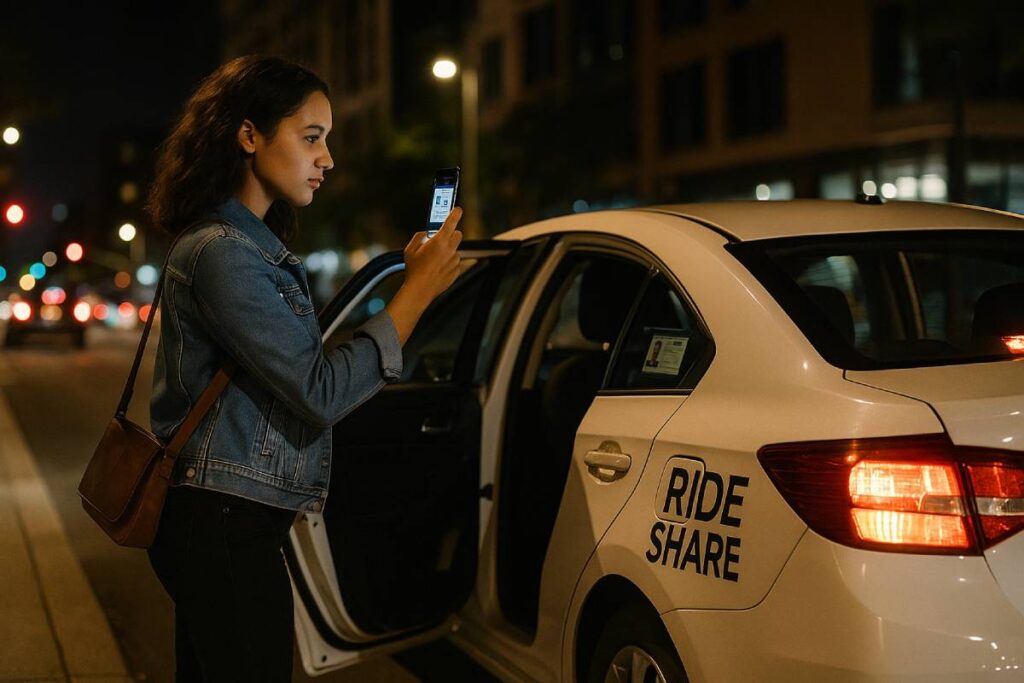
Solo female travelers can maximize safety on the move by pre-planning secure airport transfers, using only licensed public transit and vetted ride-share services, staying on well-lit, populated routes after dark, and, for road-trippers, parking in busy areas while trusting their instincts. Each of these strategies reduces exposure to risk and ensures you maintain control over your journey at every stage.
Airport & Flight Prep
Booking a single, pre-arranged transfer to your accommodation eliminates uncertainty and minimizes time spent in unregulated vehicles.
| Service Type | Pros | Tips & Actions |
|---|---|---|
| Pre-Booked Airport Transfer | Vetted drivers, fixed rates, door-to-door service | Book through reputable companies (e.g., Amstar, AirportRide), confirm driver and vehicle details, share booking confirmation with a trusted contact |
| Licensed Airport Taxi | Regulated fares, identifiable license plates, traceable via dispatch logs | Use marked taxi stands, photograph your plate and driver ID before boarding |
- Why a single transfer matters: Reduces wait times at arrivals, avoids informal taxis or touts, and prevents multiple handovers that can increase vulnerability.
- Verify credentials: Always check the driver’s ID badge and vehicle license plate against your booking details; reputable services display clear signage and driver profiles in their apps.
- Share your itinerary: Send your ride details—driver name, plate number, ETA—to a friend or family member so they can track your transfer in real time.
Public Transit & Ride-Shares
Opting for licensed public transport or official ride-share apps provides accountability and recourse if issues arise.
- Licensed Operators Only: Whether you’re boarding a city bus, train, or a rideshare, ensure the service is sanctioned by local transport authorities. In many destinations, informal minibuses lack safety standards and should be avoided.
- App-Based Rides: Platforms like Uber, Bolt, or Lyft require driver registration and maintain ride logs—you can review your journey afterward and report anomalies.
- Share & Track: Use in-app “Share My Trip” features or third-party tools (e.g., WhatsApp live-location) to allow trusted contacts to follow your route and confirm your safe arrival.
- Stay Vigilant: Note the vehicle’s license plate and driver photo, confirm your destination before departure, and trust your instincts—if something feels off, cancel and rebook.
Walking & Night Safety
Navigating unfamiliar streets at night calls for heightened awareness and strategic routing.
- Stick to Well-Lit, Populated Routes: Research your walking path in advance, favoring main roads, pedestrian zones, and areas with active evening foot traffic; crime rates rise in poorly lit, secluded spots.
- Avoid Shortcuts: Alleyways, unlit side roads, and deserted parks may save time but increase risk; a slightly longer, well-traveled route is safe.
- Move with Purpose: Walk confidently, keep your head up, and maintain a brisk pace—appear less vulnerable by behaving as though you know exactly where you’re headed.
- Emergency Preparedness: Carry a smartphone with local emergency numbers pre-saved, and consider a discreet personal alarm or whistle to deter potential threats.
Roadtrip & Van Life Caution
When the open road is your accommodation, strategic parking and intuition are your safeguards.
- Choose Well-Populated Areas: Park at established campgrounds, rest stops, or RV parks where other travelers congregate and staff may be on site .
- Position for a Quick Exit: Face your parking spot toward the exit to reduce maneuvering time if you need to leave in a hurry.
- Trust Your Instincts: If a location feels off—too isolated, poorly lit, or unmonitored—relocate immediately; solitude on the road amplifies vulnerability.
- Stay Connected: Inform friends or family of your planned stopovers, check in regularly, and use GPS-based check-in apps to broadcast your real-time location .
By integrating these transportation strategies into your travel planning, you’ll significantly reduce risks and maintain the freedom that makes solo female travel so rewarding—allowing you to focus on exploration, cultural immersion, and empowerment.
Cultural Awareness & Dress
Before charging off on your solo journey, understanding and respecting local dress codes isn’t just about conformity—it’s a critical safety strategy that signals cultural sensibility, helps you blend in, and prevents unintended offense or scrutiny. From government advisories to seasoned traveler blogs, drawing on diverse sources ensures you’re prepared for the wide spectrum of expectations you’ll encounter across destinations.
Research Local Norms for Dress & Behavior
- Consult Official Advisories: Always review the “Local Laws and Customs” section on your destination’s Travel.State.Gov page—tight-fitting clothes, sleeveless tops, or shorts may be illegal or socially unacceptable in many countries.
- Country-Specific Dress Codes:
- Qatar: Avoid wearing sleeveless shirts, halter-tops, or shorts in public spaces.
- Iran: Women must cover hair, arms, and legs at all times under government-sanctioned dress codes.
- Indonesia: Dress modestly—cover shoulders and knees—to respect local cultural norms.
- Style Guides & Etiquette Blogs: Condé Nast Traveler’s “Etiquette 101: Dress Codes” offers country-by-country style tips, from Greece’s love of gold to Germany’s minimalist chic. SisterhoodTravels’ guide provides practical outfit ideas—like pairing a kurta and leggings in India—to stay stylish and respectful.
- Street-Level Feedback: Reddit threads such as r/solotravel reveal that many solo women choose non-transparent tee shirts and long pants to avoid unwanted attention, especially in conservative regions.
| Country | Dress Requirement | Source |
|---|---|---|
| Qatar | No sleeveless tops or shorts | travel.state |
| Iran | Hair, arms, and legs must be covered | travel.state |
| Indonesia | Modest covering of shoulders and knees | travel.state |
| India | Kurta or tunic with leggings; scarf for temple visits | sisterhoodtravels |
Blend In to Avoid Unwanted Attention
Dressing to “blend in” reduces the chances of being singled out as a tourist. Opt for neutral colors and simple cuts—flashy patterns or high-end brands often draw unwelcome notice. Walking confidently in culturally appropriate attire signals that you respect local norms and deters opportunistic crime.
Takedown Stereotypes & Empower Authenticity
Embracing cultural dress codes isn’t about erasing your identity—it’s a gesture of respect that opens doors to genuine connections. Integrate local textiles or subtle motifs into your wardrobe to celebrate the destination’s heritage while maintaining comfort and authenticity. Teen Vogue reminds us that learning basic local phrases and fashion cues enhances interactions and enriches your travel experience, turning clothing into a conversation starter rather than a distraction.
By thoroughly researching dress norms, choosing attire that harmonizes with local customs, and wearing your cultural curiosity with pride, you transform every outfit into a tool for safety and cultural exchange—empowering your solo adventures with both respect and authenticity.
Situational Awareness & Intuition
Situational awareness and intuition are your most reliable safety tools when traveling solo: by tuning into that “creep radar,” keeping your personal space secure in crowds, and arming yourself with simple de-escalation tactics—like wearing a fake wedding ring or shouting “Fire!” to cut through bystander hesitation—you maintain control over your environment and dramatically reduce risk.
| Technique | Description | Source |
|---|---|---|
| Trust Your Gut | If something feels off—whether it’s a person, place, or situation—leave immediately to avoid escalating danger. | AddieAbroad; BeMyTravelMuse |
| Stay Alert in Crowds | In busy areas, carry your bag in front, keep valuables close, and scan for unusual behavior to deter opportunists. | TheBrokeBackpacker (NYC safety); TheBrokeBackpacker (Tulum) |
| De-escalation: Fake Ring | Wearing a subtle fake wedding or engagement ring signals “unavailable,” often stopping unwanted advances cold. | GoGirlGuides; Reddit community |
| De-escalation: Shout “Fire!” | A clear, urgent shout like “Fire!” cuts through bystander ambiguity and elicits aid faster than “Help!” | Psychology Today; WMU ScholarWorks |
Trust Your Gut
Your intuition—sometimes called your “creep radar”—is honed by countless micro-cues you subconsciously process. When you sense you’re being watched, followed, or simply that something isn’t right, remove yourself from the situation without hesitation.As 30 veteran solo female travelers attest, “if you get that weird feeling…listen to it,” because your instinct has saved countless women from harm.
Stay Alert in Crowds
Busy streets, markets, and transit hubs are prime pickpocket grounds. Always carry your bag in front of you—strap tight, zipper closed—and keep your hand or arm looped through the handle for rapid retrieval. In well-traveled tourist zones like Tulum, experts warn that crowded plazas are where “pickpocketing can be a problem,” so maintain a broad field of vision and avoid distractions like headphones when moving through dense crowds.
De-escalation Tips
- Fake Wedding/Engagement Ring: A simple, low-cost decoy ring conveys you’re “taken,” prompting many would-be harassers to back off immediately. Travelers report that flashing a faux band stopped unwanted advances on the spot—no confrontation needed.
- Shout “Fire!” Instead of “Help!” In emergencies, people rush toward perceived danger to help—unlike hearing “Help,” which can trigger hesitation. Self-defense instructors and psychologists alike recommend yelling “Fire!” to cut through uncertainty and draw rapid assistance.
By sharpening your situational awareness, honoring your intuition, and mastering these straightforward de-escalation techniques, you transform potential vulnerabilities into proactive safety measures—so you can explore the world with confidence and control.
Money & Document Security
When it comes to protecting your money and critical documents on the road, layering your strategies—both physical and digital—makes all the difference. Split your cash and cards across hidden on-body storage and separate pouches, remain vigilant at ATMs by choosing well-lit, bank-affiliated machines and inspecting for skimmers, and ensure you have backup copies (both paper and encrypted digital) of your vital documents. Finally, leverage secure storage at your accommodation—using hotel safes when available and a lightweight portable safe when not—to keep your originals out of harm’s way while you explore.
Split Cash & Cards: Use Hidden Belts
Disperse funds and payment methods rather than keeping everything in one wallet. Store emergency cash and backup cards in a slim, hidden money belt worn beneath your clothing—this low-profile pouch is far less conspicuous than a bulging wallet and keeps your reserves secure if your purse is snatched.
- Expert Tip: Seasoned travelers like those at The Broke Backpacker stress diversifying funds: carry only a day’s spending cash in your main wallet, and stow the rest (including backup cards) in secured, separate locations.
- Pro Advice: Follow Addie Abroad’s guidance to keep spare cards and a small emergency cash stash in a concealed pouch inside your luggage, so you’re never stranded if something goes missing.
ATM Vigilance
When withdrawing cash, favor ATMs located inside banks, shopping malls, or well-lit hotel lobbies to reduce skimming and shoulder-surfing risks.
| Best Practices | Why It Matters |
|---|---|
| Use bank-affiliated machines | Regularly serviced and monitored, less prone to skimmers |
| Inspect for tampering | Look for loose card slots or attachments before inserting your card |
| Shield your PIN entry | Position your hand over the keypad to block hidden cameras |
| Count cash discreetly | Step aside to verify your withdrawal before returning to your purse |
Photocopies & Digital Backups
Maintain paper and electronic copies of passports, visas, travel insurance, and emergency contacts:
- Print & Carry: Keep one set of photocopies in your daypack, separate from the originals, to present to authorities if needed.
- Cloud Storage: Upload encrypted scans to services like Google Drive or Dropbox with two-factor authentication, ensuring you can retrieve them even if all your devices are lost or stolen.
- Email Archive: Email copies to a trusted friend or family member who can forward them back if required.
Secure On-Site Storage
When your accommodation offers an in-room safe, use it—but don’t rely on it exclusively. Combine built-in hotel safes with a portable travel safe or lockbox that can be tethered to a fixed element in the room.
- Portable Safes: Compact, cable-attachable boxes protect passports, electronics, and jewelry, and can be taken with you if you change rooms or properties.
- Hotel Safe Tips: Always test the safe’s locking mechanism upon arrival and change its code yourself; store only high-value items and keep smaller essentials on your person.
By splitting your funds, staying vigilant at ATMs, backing up documents, and leveraging secure storage, you create overlapping defenses that safeguard your finances and identity—letting you focus on the joy of solo exploration rather than what might go wrong.
Emergency Preparedness & Communication
Before you head out on your solo adventure, make sure you’re fully equipped to handle any crisis by: saving vital emergency numbers and embassy hotlines, leveraging technology to stay connected, and building a financial safety net with both cash reserves and insurance coverage. Below you’ll find concrete steps, data-backed insights, and practical tools to keep you prepared and confident on the road.
Know Local Emergency Numbers & Embassy Contacts
Researching and storing the right phone numbers before departure is critical—every second counts in an emergency.
| Service | Number | Notes |
|---|---|---|
| General Emergency (EU) | 112 | Redirects to local police, fire, ambulance in EU countries |
| General Emergency (USA) | 911 | Universal U.S. emergency hotline |
| U.S. Crisis Hotline (U.S./Canada) | 1-888-407-4747 | Office of Overseas Citizens Services for U.S. citizens abroad |
| U.S. Crisis Hotline (International) | +1 202-501-4444 | Office of Overseas Citizens Services for callers outside North America |
| Nearest U.S. Embassy/Consulate | Varies by country | Embassy locator and consular emergency info on Travel.State.Gov |
| Community-Sourced Alerts | Save subreddit threads | Real-time tips (e.g., r/Coimbatore for local numbers) |
- Tip: Store these numbers in your phone’s speed-dial and keep a paper backup in your daypack.
Use Live Check-Ins, Location-Sharing & GPS Trackers
Modern apps and devices turn isolation into accountability, ensuring someone always knows where you are.
| Tool / App | Feature | Citation |
|---|---|---|
| bSafe | SOS button, live-location, voice-activation | leaderstat |
| Life360 | Real-time family/friend check-ins & alerts | leaderstat |
| Personal GPS Tracker (LandAirSea) | Real-time satellite tracking, emergency alerts | landairsea |
| Safety Apps Roundup (SoloTravelerWorld) | Multi-app list with offline modes & timed check-ins | solotravelerworld |
| STEP (U.S. Smart Traveler Enrollment Program) | Embassy alerts & emergency notifications | travel.state |
| Wearable SOS Tech (WIRED) | InvisaWear jewelry, Apple Watch SOS, Garmin incident detection | wired |
- Best Practice: Schedule automated “I’m OK” check-ins with a trusted contact or use in-app timers that alert others if you don’t check in on time.
Have Backup Funds & Use Insurance If Needed
A financial cushion—both physical cash and robust insurance—turns unexpected expenses into manageable hiccups.
| Strategy | Recommendation | Source |
|---|---|---|
| Emergency Cash | Keep 3–5 days’ worth of basic expenses in local currency, stored separately from main wallet | |
| Hidden Backup Cards | Stow spare credit/debit cards in a money belt or concealed pouch | |
| Portable Travel Safe | Use cable-lock safes or hotel-room safes for bulk funds when resting | |
| Insurance Coverage | Allocate 4–10% of trip cost to comprehensive travel insurance covering health, theft, evacuation | |
| Policy Selection | Opt for plans with 24/7 assistance, trip interruption, medical evacuation; top providers include Allianz, World Nomads, SafetyWing | |
| Financial Emergency Plan | Share policy details & insurer contacts with a friend/family member; email copies of insurance docs |
- Quick Tip: Before departure, use a service like InsureMyTrip or NerdWallet to compare solo-focused policies and confirm coverage limits for women’s health and personal belongings.
By integrating these proactive measures—storing the right hotlines, leveraging connectivity tools, and securing a financial safety net—you’ll transform potential vulnerabilities into pillars of confidence. Ready to dive in? Save this guide, update your travel app settings, and enjoy your journey with peace of mind.
Social & Nightlife Situations
Solo female travelers often find the social and nightlife scene one of the most rewarding—and the riskiest—as it blends independence with new social dynamics. By joining communal dining experiences, guarding your digital footprint, and keeping a vigilant eye on drink preparation and consumption, you can maximize fun while minimizing risk. Below are expert-backed tactics for each scenario.
Dining Solo
Even as a lone traveler, you can turn meals into social—and safe—experiences by tapping into group tables and curated food apps.
- Join Group Tables & Supper Clubs
Platforms like EatWith and Airbnb Experiences connect you with vetted hosts and fellow diners for small dinner parties and cooking workshops in over 130 countries. Reviews and ratings let you choose well-attended, women-friendly events.
| Platform | Description | Reach & Reviews |
|---|---|---|
| EatWith | Home-hosted dinners & cooking classes | 130+ countries; user ratings for safety |
| Airbnb Experiences | Local-led supper clubs & food tours | Verified reviews; small group sizes (<12) |
Avoid Over-Sharing Travel Plans in Real Time
Broadcasting your every move can inadvertently alert opportunists to your unguarded moments—keep details on a need-to-know basis.
- Limit Social Media Check-Ins
Avoid posting live updates of your exact location or itinerary; instead, share broad highlights after the fact to keep friends in the loop without exposing your real-time whereabouts. - Vague Descriptions with New Acquaintances
In hostels or bars, keep first-meet chatter general—don’t reveal your next stop or accommodation until you trust someone fully. - Control Your Audience
Adjust social-media privacy settings and use close-friends lists to share location only with vetted contacts.
Watch Drink Preparation & Alcohol Intake
Bars and clubs can pose unique hazards—from spiking to impaired judgment—so adopt these best practices:
| Best Practice | Why It Matters | Source |
|---|---|---|
| Watch Your Drink | Prevent spiking and avoid theft | nomadicmatt |
| Ask for Drinks Opened in Front of You | Ensure bottles aren’t tampered with | cntraveler |
| Never Accept Drinks from Strangers | Reduces risk of being targeted | nomadicmatt |
| Limit Your Intake | Keeps you alert and in control | nomadicmatt |
| Stay Near the Bar | Makes monitoring easier and deters opportunists | nomadicmatt |
- Never Leave Drinks Unattended: Even a momentary lapse can be exploited—hold your drink or ask the bartender to keep an eye on it.
- Pace Yourself: Stick to your known limits; intoxication undermines situational awareness and can cloud judgment.
By leveraging communal dining platforms, maintaining a guarded digital presence, and treating bars with the same caution as banks, you’ll transform nightlife into a cornerstone of your solo adventure—brimming with connection, culture, and confidence.
Personal Anecdotes & Expert Quotes
Solo female travelers often find that the most memorable moments come from the connections they forge and the confidence they gain. From winding the Camino de Santiago alongside fellow pilgrims to sharing wins on niche online forums, these personal stories and expert insights highlight how supportive communities and self-reliance empower women on the road.
Personal Testimonials
| Traveler & Context | Quote |
|---|---|
| Becca, Camino pilgrim | “Camino de Santiago is actually one of the safest trips you can take.” |
| Mikala Whitaker, Unanchored Passenger author | “I felt incredibly safe the whole time.” |
| Reddit user, r/solofemaletravellers | “I definitely think that solo travel helped build my self esteem! It’s enforced the idea that I’m independent and perfectly capable of thriving on my own.” |
Expert Quotes
- “The beauty of traveling solo, especially as a female, has also taught me so much about myself. It’s made me more independent, stronger, and more resilient.” — Nomadic Matt
- “The most common issue people have is passport theft, so keep yours in a safe place while traveling,” says Belau. — Forbes
- “It’s empowering; you’re the boss—but no one’s calling you bossy.” — Lonely Planet on the benefits of solo female travel
- “We help women get out there and gain the confidence and support we need to travel solo.” — Wanderful community mission statement
- “Women are putting a new spin on the idea of ‘solo’ travel by signing on for small-group adventures.” — Travel + Leisure on evolving solo travel trends
- “Take your time. Don’t rush. Travel light. Follow your passions.” — Advice from non-millennial solo female travelers
- “42% of Americans opted to vacation alone in 2024, reflecting the growing embrace of solo journeys.” — Express News
These firsthand accounts and expert voices underscore two truths: the women’s travel community is fiercely supportive, and the act of stepping out alone inherently builds resilience and confidence. Whether you’re sharing a bed in an albergue on the Camino or asking fellow travelers for tips online, you’re part of a global sisterhood that celebrates—rather than fears—solo exploration.
Destinations with Specific Advice
From ultra-safe city-states to continent-wide transport networks and the hidden risks of road-based living, targeted destination advice equips you to plan confidently. Singapore combines top-tier safety rankings, well-lit streets, and a world-class transit system for worry-free exploration.
In Europe, seamless public transportation and the supportive Camino de Santiago pilgrimage trail make solo journeys both easy and secure. By contrast, van life—while liberating—demands extra vigilance in isolated parking zones and remote boondocks where help can be far away. Use these data-driven insights to choose your next adventure—and know where to tread carefully.
Singapore: Safe, Well-Lit & Efficient
Singapore consistently ranks among the world’s safest destinations, offering solo travelers peace of mind around the clock. In 2022, the Global Peace Index placed Singapore as the top country in Asia for societal safety and security, and ninth globally. Violent crime rates are extremely low, with near-zero homicide incidents reported annually.
Public spaces—from downtown streets to MRT stations—are uniformly well-lit, and 24/7 security patrols further bolster nighttime safety. Singapore’s Mass Rapid Transit (MRT) network and bus system maintain punctual, secure operations even past midnight, enabling stress-free solo excursions. With English as an official language, communication barriers vanish, making navigation and local interaction seamless.
| Aspect | Details |
|---|---|
| Safety Ranking | #1 in Asia, 9th globally on Global Peace Index |
| Violent Crime Rate | Near-zero homicide rate; minimal violent incidents |
| Street & Station Lighting | Uniformly well-lit public areas, even late at night |
| Public Transport | Efficient, secure MRT and bus networks operating 24/7 |
| Language Accessibility | English widely spoken; official language status reduces misunderstandings |
Europe Essentials: Reliable Transit & Camino de Santiago
Europe’s advanced, interconnected transit systems—from high-speed trains to urban metros—are a solo traveler’s dream, providing punctual, safe passage across borders and cities. An analysis of top solo-friendly routes highlights Europe’s rail networks for their low crime rates, digital ticketing security, and frequent service intervals. Metro systems like Madrid’s and Berlin’s are lauded for cleanliness, lighting, and staff presence, ensuring peace of mind after dark.
Walking the Camino de Santiago offers another layer of security through community and infrastructure. Pilgrims report that the well-marked trails, regular albergue (hostel) stops, and supportive international crowd create one of the safest long-distance hikes in the world. Spain’s Camino Francés alone hosts over 200,000 pilgrims annually, with dedicated mobile apps and guidebooks reinforcing trail safety and logistics.
| Element | Insights |
|---|---|
| Integrated Transit | Europe’s rail, bus, and metro networks offer cross-border connectivity with low crime and high digital security |
| Punctuality & Reliability | Frequent, on-time service reduces wait-time exposure; systems often staffed or monitored 24/7 |
| Camino Community | Strong pilgrim camaraderie and albergue infrastructure foster both social and physical safety |
| Trail Marking & Support | Well-marked routes and companion apps guide solo hikers; few safety incidents beyond minor injuries |
Caution Zones for Solo Van Travellers
Van life offers unparalleled freedom, but certain environments amplify vulnerability—especially when traveling alone. Prioritize well-populated, monitored spots and avoid isolated or poorly-reviewed parking areas.
| Zone | Risks |
|---|---|
| Remote Boondocking Areas | Limited cell service, wildlife encounters, delayed help; use iOverlander to vet legal, reviewed campsites |
| Highway Rest Stops & Truck Stops | Few witnesses, limited lighting; prefer designated rest areas with security cameras and trucker presence |
| Urban Backstreets After Dark | Increased risk of theft or assault; park near streetlights and CCTV-equipped areas |
| Unreviewed or Signless Parking | Unknown safety history; always check online reviews or local crime maps before settling |
| Domestic Campgrounds in Isolation | Incidents of domestic violence highlighted by high-profile cases (e.g., Gabby Petito); trust your instincts and relocate if uneasy. |
- Scout Before Sundown: Aim to arrive at campsites before dusk; daylight scoping reduces surprises and ensures you choose the safest spot.
- Lock & Light: Always park facing the exit for quick egress, lock all doors, and use exterior lights or reflectors to deter intruders.
- Stay Connected: Maintain a mobile hotspot or satellite tracker—remote areas can drop cell signals unexpectedly.
- Plan Exit Routes: Position your van so you can drive forward; avoid being boxed in by obstacles or other vehicles.
By tailoring your approach to each destination’s unique environment—leveraging Singapore’s peerless safety, Europe’s transit infrastructure and Camino solidarity, and prudent site selection for van life—you’ll maximise security and confidence wherever the road takes you.
Debunking Myths
While it’s tempting to rely on physical deterrents or let fear dictate your decisions, both approaches can backfire—pepper spray, stun devices, and firearms are often illegal abroad, and an overemphasis on fear can paralyze rather than protect. By debunking these myths and adopting a mindset of proactive preparation—through research, situational awareness, and practical planning—you’ll travel safer and with far greater confidence.
Gun / Pepper Spray Often Illegal; Self-Defence Gear Can Be More Harmful
In many popular destinations—especially across Europe—pepper spray and mace are classified as prohibited weapons, making possession a criminal offense even when used in self-defense. The TSA does permit up to 4 oz of pepper spray in checked baggage, but carry-on storage is strictly forbidden and international regulations vary widely.
Numerous travelers report confiscation or fines when attempting to bring pepper spray into countries like Morocco or Germany, where local law distinguishes animal-control sprays from human-use irritants. Likewise, stun guns, tactical pens, and other self-defense devices often fall under banned-weapons statutes—and carry the added risk of physical blowback or legal entanglement if misused.
| Myth | Reality |
|---|---|
| “Pepper spray is universally legal for self-defense.” | Illegal in many European countries; import/export strictly controlled; carry-on pepper spray banned by TSA |
| “Carrying a stun gun will keep me safe.” | Stun guns and tasers are prohibited for civilian use in multiple jurisdictions; risk of severe injury or arrest |
| “Guns are the ultimate protection.” | Firearms licensing for tourists is virtually non-existent in most nations; penalties for illegal possession can be severe |
Fear Does Not Equate Danger—Empower Preparation
“Fears are educated into us, and can, if we wish, be educated out,” reminds psychiatrist Karl A. Menninger—showing that many travel anxieties stem from myths rather than real threats. Seth Godin adds, “If it scares you, it might be a good thing to try,” illustrating how reframing fear as opportunity fuels growth on the road.
Instead of letting fear dictate your choices, focus on concrete safety steps—thorough destination research, situational awareness, and reliable backups for documents and funds—to convert anxiety into actionable confidence. As Ella Maillart observed, “You do not travel if you are afraid of the unknown; you travel for the unknown”—embracing preparation over panic unlocks authentic exploration and resilience. By viewing fear as a cue to prepare rather than a signal to retreat, solo female travelers can enjoy the full rewards of independent travel without unnecessary apprehension.
Conclusion
Solo female travel is a thrilling pathway to personal growth—and safety need not be a barrier but a built-in compass guiding every decision. From the moment you begin researching destinations on official advisories and traveler forums, through methodical packing of anti-theft gear and safety apps, to the nuanced art of blending into local cultures, each step builds momentum toward a truly empowered journey.
Airport pickups become seamless, accommodations transform into secure havens, and nighttime strolls feel less daunting when you trust your instincts and de-escalation techniques. With your documents backed up digitally, emergency contacts at your fingertips, and a network of global female travel communities sharing wisdom, you stand firmly in control.
Embrace preparation over fear, and let every interaction—from group dinners on EatWith to solo hikes on the Camino—reinforce your resilience. This guide isn’t just a safety checklist; it’s a blueprint for confident independence and unforgettable exploration.
FAQs
What essentials should I pack for solo female travel?
Always include a money belt, portable charger, door alarm, personal alarm, anti-theft bag, and safety apps like bSafe and Google Maps offline.
How can I stay safe when using ride-share services?
Stick to licensed apps (Uber/Bolt), verify driver details, share your trip, and sit in the back seat for extra distance.
Are pepper spray or stun guns legal abroad?
Often not—many countries ban these items. Check local laws before packing any self-defense gear.
What should I do if I feel unsafe at my accommodation?
Use a door wedge alarm, relocate rooms, or switch properties if locks aren’t secure. Always report issues to front desk.
How do I keep my documents safe?
Store originals in hotel safes or a portable lockbox; keep encrypted digital backups and physical photocopies separate from your IDs.

